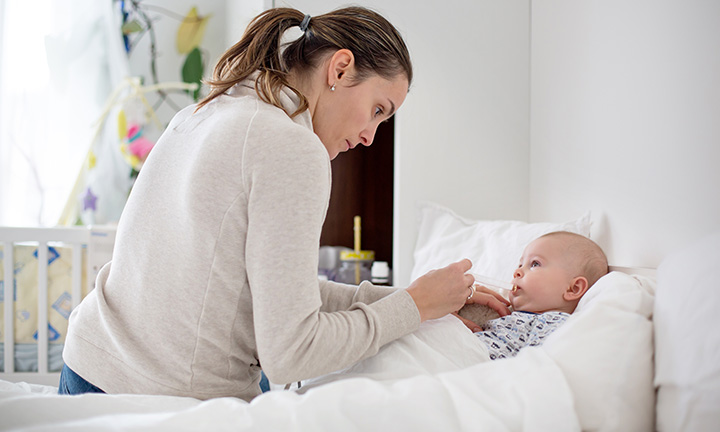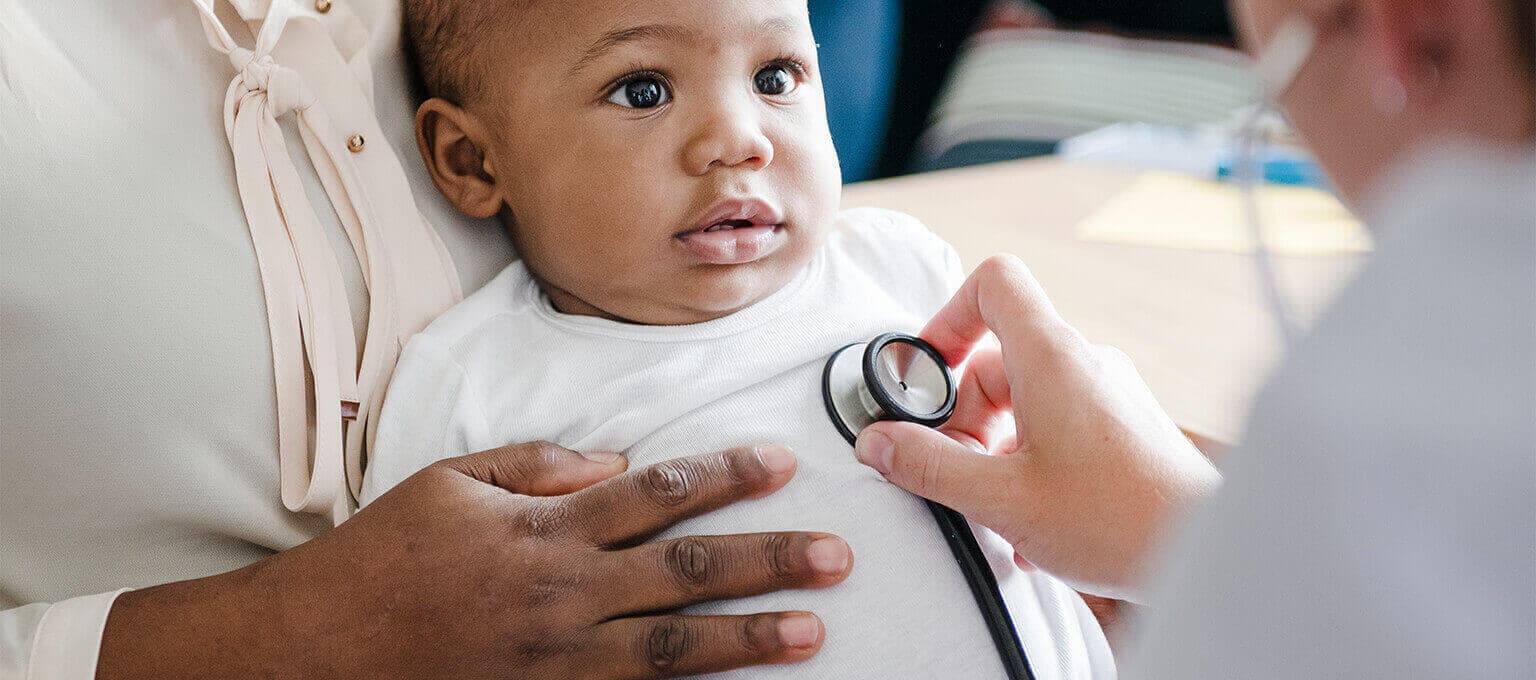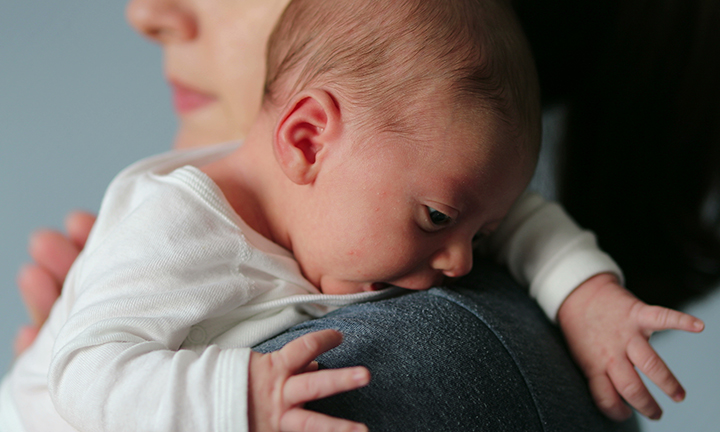
Baby Arching Back: Why Do Babies Arch Their Backs?


Does your little one keep arching their back? If so, you might be curious to know why babies do this. Maybe you notice your baby arching their back when crying, or while sleeping. Or maybe there’s no pattern at all and your baby is simply a casual acrobat! Read on to learn more about this curious movement, including why it happens and when it could be cause for concern.
Why Do Babies Arch Their Backs?
A baby who is arching their back may be doing so for a number of reasons, and very few are cause for concern. Babies and newborns most often arch their backs while they’re crying, and sometimes when nursing, eating, sleeping, or working on motor development. It’s typically just an expressive movement, a way to communicate, or a reflexive motion in reaction to something. However, if back arching accompanies certain symptoms, it could indicate a health condition. We’ve rounded up the most common reasons why babies arch their backs along with guidance on when you do and don’t need to contact your child’s healthcare provider.
Gas and Reflux
A gassy baby can also be a back-arching baby! When you’re feeding your little one, they may eat too fast or swallow air, which can cause gas. And because gas can lead to an upset stomach and discomfort, your child may move around, arching their back or pulling their legs up to find some relief.
Tip
Help relieve your baby’s gas pains by putting them on the left side and rubbing their back. This positioning helps increase circulation and supports the stomach when digesting.
Similarly, if your infant or baby is arching their back while nursing, or perhaps when eating solid foods, it could be a sign of reflux. Gastroesophageal reflux (GER) is when your baby’s food comes back up through the esophagus after feeding. Gassiness and GER are nothing to worry about unless they’re prolonged or accompany other symptoms. For example, if your baby is crying and arching their back after eating, it could be a sign of a food allergy or sensitivity. And if GER lasts more than 12 to 14 months, it could be a condition called gastroesophageal reflux disease (GERD) and may require some feeding adjustments or medical intervention. If you’re going through quite a few diapers these days, download our Pampers Rewards App to start earning rewards on all your diapers and wipes purchases. Do you know the right diaper size for your baby? Take the quiz below to find out!
Building Muscles and Motor Skills
As your baby progresses beyond the newborn stage, you’ll start to see more and more movement. Your little one is busy working on developing muscle strength and control—especially in the back and neck muscles—which they need to master to reach important development milestones, like sitting up. Arching the back may be part of this exciting process. For example, at around 4 months or a little later, your baby may start trying to lift their chest, which involves pushing up on the arms and arching the back. These infant pushups help build upper body strength and balance, which your baby needs to stay stable and upright when sitting. You might also see your baby arching their back while they rock on their stomach, kicking their legs and doing a swimming motion with their arms—all of this is to prepare for rolling over and sitting up. You can help your baby practice their moves and build those essential muscles by including tummy time in your daily routine. Always make sure to stay close to your baby during tummy time sessions.
Being Overstimulated or Colicky
Babies cry often and for different reasons—they could be bored or tired, hungry or uncomfortable. Crying is how they communicate. And when babies cry because they’ve become overstimulated, they may arch their back at the same time. It’s common for colicky babies to arch their backs during crying spells, too. Here are a few things that babies may be reacting to or experiencing when they’re crying and arching their backs:
Tip
Some babies suffer from colic, and a common sign is arching their backs while crying or screaming. But if your baby does this, it doesn’t necessarily mean it’s colic.
Sleeping, Nursing, Eating, and Teething
Sometimes babies or newborns arch their backs while doing everyday things, like nursing or sleeping, or while going through the teething stage. Here is additional insight on what it means when your baby arches their back in these situations:
In Summary
If your baby is arching the back during everyday activities, like sleeping, eating, and nursing, it could be connected to gas, reflux, or stretching.
What to Do and When to Contact Your Healthcare Provider
By now, you probably understand that a newborn or older baby arching their back is natural, normal, and typically not a cause for concern. However, if your baby is arching their back because of discomfort or pain, it could be related to a health condition. There are a few things you can do at home to help your baby, but if this movement accompanies more serious symptoms, it’s best to contact your child’s healthcare provider to rule out any medical issues that may require treatment. In the chart below, you’ll find a few home remedies to help you with issues causing your baby to arch the back. However, if you notice any of the serious symptoms listed, contact your child’s healthcare provider.
When babies arch their backs, it’s mostly related to normal development or common conditions that you and your child’s healthcare provider can manage from home. However, there are some additional, more complicated issues that could cause your baby to arch their back. Very rarely, persistent back arching—when accompanied by symptoms such as skin color changes and eye movement—could be associated with seizures. Be sure to consult the provider when:
Usually, back-arching isn’t something to worry about, but it’s always best to double-check with your child’s healthcare provider.
FAQS AT A GLANCE
Babies arch their backs for different reasons. Most often it happens as they move around and work on developing back muscles and motor skills, or when crying. However, sometimes babies arch their backs out of discomfort or pain caused by gas, reflux, or something more serious.
The Bottom Line
You may be asking yourself, “Why does my baby boy or girl arch his or her back?”—and you’re not the only parent wondering about this curious little behavior! You may notice your baby or newborn arching their back when tired, hungry, uncomfortable, or upset. Other reasons include your little one having gas or reflux, or wanting to show off new back muscle skills. This behavior isn’t typically something to worry about but be sure to contact your child’s healthcare provider with any questions or concerns. Together, you can explore why your baby arches their back and determine if any medical intervention or treatment is necessary. Most likely, your little acrobat is simply expressing themselves with this natural and normal movement!
- American Academy of Pediatrics. Caring for Your Baby and Young Child: Birth to Age 5, 7th ed. (New York: Bantam Books, 2019).
- Cleveland Clinic. Kernicterus
- Cleveland Clinic. “Colic.”
- Cleveland Clinic. “Temper Tantrums.”
- Kids Health. “Colic.”
- Kids Health. “Movement, Coordination, and Your Newborn.”
- Kids Health. “Temper Tantrums.”
- Healthy Children. “Baby Teething Pain.”
- Healthy Children. “Breaking Up Gas.”
- Healthy Children. “Gastroesophageal Reflux & Gastroesophageal Reflux Disease: Parent FAQs.”
- Healthy Children. “How to Calm a Fussy Baby: Tips for Parents & Caregivers.”
- Healthy Children. “How to Keep Your Sleeping Baby Safe: AAP Policy Explained.”
- Healthy Children. “Lactose Intolerance in Infants & Children: Parent FAQs.”
- Healthy Children. “Movement Milestones: Babies 4 to 7 Months.”
- Healthy Children. “States of Consciousness in Newborns.”
- Medline Plus. “Abdominal Pain—Children Under Age 12.”
- Zero to Three. “From Baby to Big Kid: Month 2.”
Read more about Baby
Related Articles
Join a World of Support
through Pregnancy and Parenthood.
TRACK WITH TOOLS
LEARN WITH EXPERTS
GET REWARDED
















